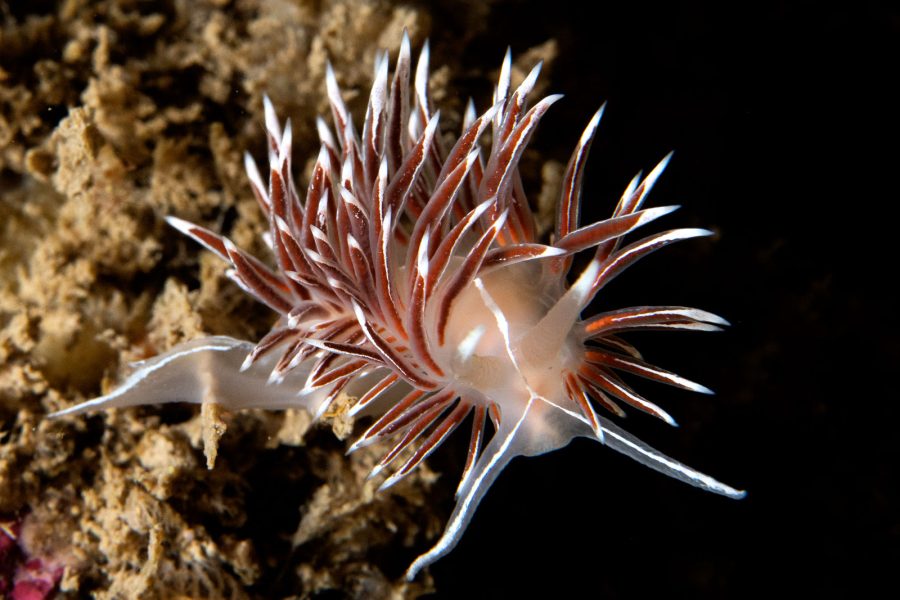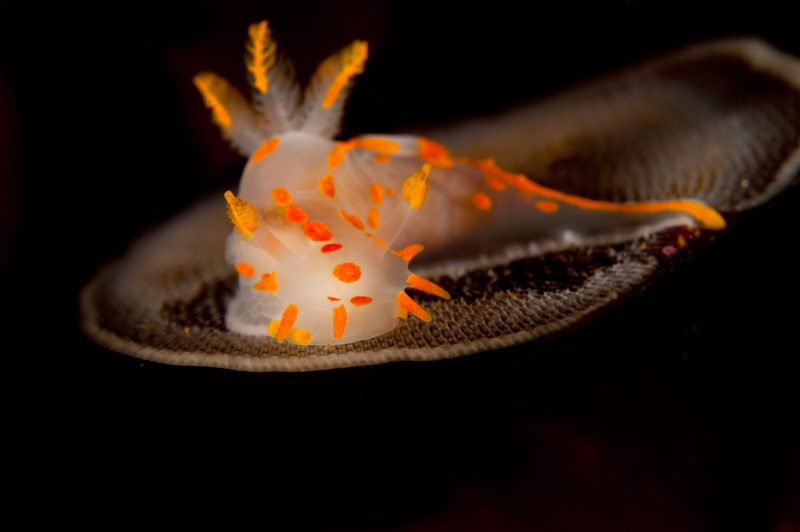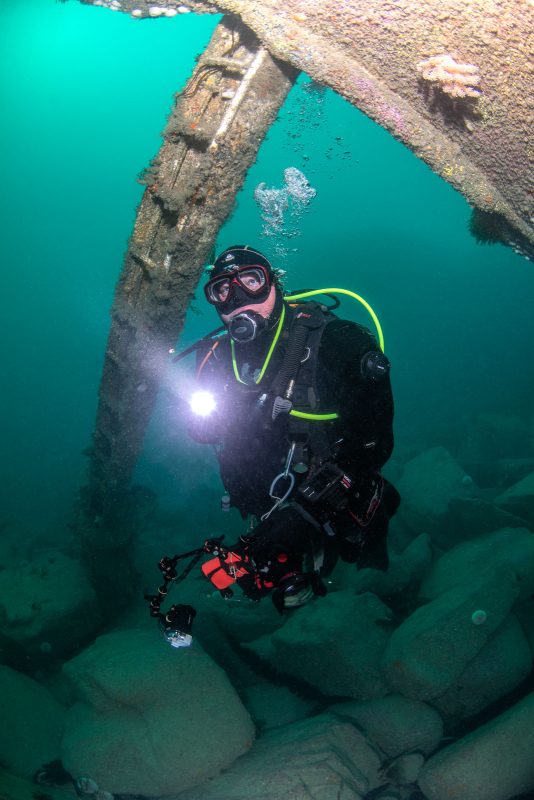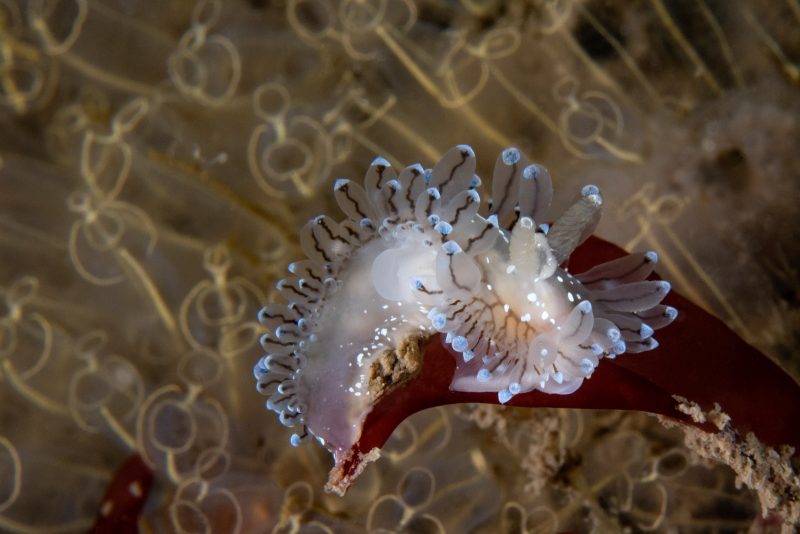5 Best Underwater Photography Locations in the UK

It’s quite possible that the UK isn’t the first place that comes to mind when dreaming of diving trips but, in reality, it offers so much to see. For starters, the UK’s coastline boasts more wrecks per mile than anywhere else in the world, from the German fleet of Scapa Flow, to purposely sunk artificial reefs.
But it’s not all about wrecks; this diverse marine environment has so much to offer, from offshore reefs and drifts to caves and gullies. The marine life is also hard to beat, including tiny macro critters, seals, blue sharks, and rays, all the way up to the second largest fish in the sea, the basking shark.


Read more: 5 Underwater Species to Photograph in the UK
Along with the incredible coastline, there are also plenty of sea lochs and inshore sites, meaning there is something to whet even the most discerning underwater photographer’s appetite. Here’s a whistle-stop tour of five of my personal favourites.
1. St Kilda
I’ll never forget falling asleep in Leverburgh on Harris, and waking up to the view of the most remote part of the British Isles standing proudly on the horizon. They are the highest sea cliffs and stacks in Great Britain, towering up to 165m above the sea. They have volcanic origins and once formed the rim of a volcano that first erupted 50 to 60 million years ago.
It has always been a mecca for British divers, so I just had to include this remote outpost. The underwater photography opportunities may be the main attraction, but part of the charm is its wild and rugged scenery, and that it is not the easiest place to access. It is located 100 miles from the mainland, and weather often blows out visiting boat trips.
My favourite dive is the Saw Cut, which is basically a 3 metre crack in the rock, running about 60 metres deep into the Dun. Within the fissure the visibility is crystal clear, giving a glimpse of the famed 40 metres of visibility that the area is famed for.
The floor of the gully there was stacked out with dahlia anemones, inside of which tiny shrimps and amphipods were hiding. But the best part of the dive was seeing the walls at the entrance: festooned with vibrantly coloured jewel anemones.
Fantastic opportunities for wide-angle, macro, and super-macro are on offer here, as many tiny skeleton shrimps can be seen, busy amongst the anemones.
You may also enjoy some deeper dives, finding interesting caves, underwater archways, and playful seals. Many of the walls are stunning, as they are covered in numerous vibrantly coloured anemones and brittle stars.
To access St Kilda you really need to be booked onto a liveaboard, and departures are generally from the Isles of Skye or Harris. Getting to the islands can be challenging, and so the summer months are often the most successful.
I dived St Kilda with skipper Bob Anderson on the MV Halton, sailing from Orkney. The more usual route would be from Skye or Harris. Bob Jones offers trips each summer on his boat the Gaelic Rose. You do need to book well in advance (at least a year), as spaces are snapped up.
2. Scapa Flow
British divers love their wrecks, and wreck photography in the Flow is about as good as it gets. On the 21st June 1919 the German fleet were scuttled, after having been interned pending armistice negotiations. 52 ships came to rest on the seabed that day, which is still the greatest loss of shipping recorded in a single day.
Most of the ships were raised in an enormous salvage operation, but seven remain sunk to this day. Three battleships and four light cruisers are now part of a living museum in the sea, and are a dream to photograph.
The Cöln is one of my personal favourites, although all the ships have some wonderful features. The Cöln is a light cruiser, lying from 36 metres at the deepest to 22 metres at the shallowest point.
The armoured control tower and bridge are two of the best features but, more importantly, all the structure is smothered in life. Filter feeders, such as plumose anemones, cling onto the chains, bringing colour and life to the ageing structure.
Most photographers stick to wide-angle at Scapa, for the obvious reason: doing these huge wrecks justice. However, you could easily take a trip with just a macro lens, as there is a vast amount of small life that is often overlooked.
Due to the depth of the battleships and light cruisers, you will sometimes battle with the light. So, having a camera that affords you the ability to increase your ISO without losing out on quality to digital noise is a bonus. Also, if you want to photograph the inside of some of these wrecks, you’ll need a good spotter light and a couple of powerful strobes.
It’s very helpful to have a buddy who is happy to model for you, as this gives a sense of perspective to the size of the wrecks. I generally favour a fisheye or other ultra-wide lens at Scapa, so that I can get really close to the features. You just need to be aware of the distortion that comes with using a fisheye lens.
Should you get bored of the battleships and light cruisers, Burra Sound and the Block Ships also offer incredible photographic opportunities. Due to their shallower depths the light can be captured wonderfully, shining through the ageing structure.
Dive boats generally operate from May through to October. There are lots of dive boat operators in Stromness to choose from, all offering diving in the Flow. You can opt for a day boat or liveaboard. I dived with skipper Bob Anderson on the MV Halton, since traded in for a new boat, the Clasina.
Read more: 8 Tips for Creating Amazing Lighting in Underwater Photos
3. The Isles of Scilly
The Isles of Scilly are as far south and west as you can go in the UK, just 28 miles southwest of the Cornish peninsula. They are the warmest place in Great Britain, located on the Gulf Stream and so enjoying a subtropical climate.
Therefore, it offers no surprise that the archipelago acts as a marine bridge between the warmer waters of the Atlantic and the cooler waters of the UK, leading to sightings of warmer climate species. Although recently, they have also been hosting an animal from much colder climes, with a long summer visit from Wally the Walrus.
Due to their position, the Isles are swept with strong, nutrient-rich currents, and these create an ideal habitat for filter feeders, including one of my personal favourites, the jewel anemone. The clear, deep waters also allow for light penetration that is rarely seen in the UK and, as a result, there are kelp forests and seaweed meadows at 20 metres deep.
The wrecks, of which there are a few to choose from, are also incredible habitats for a variety of marine life forms.
The Isles of Scilly are great for wide-angle photography, with stunning walls of anemones, gullies, friendly grey seals, wrecks, and clear water. My personal favourite is still looking for the tiny life. Wingletang Wall is the best site that I’ve found for spotting minute skeleton shrimp hiding within the anemones.
This sheer, kelp-topped wall is to the south of the island of St Agnes, and is smothered with multiple coloured jewel and plumose anemones. The reef plummets down to 20 metres and, just off the main wall, you can also see pink finger corals and the rare sunset cup corals.
However, I could spend the dive in just one spot, peering through a super-macro lens watching for skeleton shrimp living amongst the anemones. It’s just like watching an alien world in miniature.
I managed to photograph the skeleton shrimp using a Nikon D500 in a Nauticam housing. Finding the really tiny stuff was made much easier by using a Nauticam 180 degree viewfinder, a 105mm lens, and a Nauticam SMC (super macro converter). When taking photos of tiny critters that are rarely bigger than a thread of cotton, it’s important to make your life as easy as possible.
I took most of my skeleton shrimp shots by stopping down my aperture to around f/36, to give myself a greater depth of field. Skeleton shrimps tend to keep very busy, and so are continuously moving. I also used 1/250th of a second shutter speed to help freeze the action.
I wasn’t too worried about the loss of light as, when you are working that closely to a subject, nearly all the light comes from your strobes. However, I gave the camera a little help by increasing my ISO to 320.
The best way to access the Isles of Scilly, especially if you are taking lots of dive gear and camera kit, is via the Scillonian passenger ship from Penzance in West Cornwall. Dive operators are currently unsure for the next season, but watch that space.
4. Farne Islands
There are a few great spots in the UK for photographing our beautiful and charismatic grey seals. The Isles of Scilly and Lundy are always productive, but I’ve probably had some of my best encounters in the Farne Islands.
These 28 islands are just a few miles from Seahouses, about a one-hour drive from Newcastle on the Northumberland coast. You need to board a boat from the harbour in Seahouses, and there are several operators to choose from.
The journey out on the boat is wonderful, as the islands are also home to many seabirds. Underwater, the topography is equally as good. My most successful photo from the Farne Islands was taken on a dive at around 20 metres, when I was concentrating on the starfish and lobsters hiding in the reef.
Intuitively, I realised I was being watched, and glanced briefly over my shoulder. I spotted a young female grey seal watching me and moving gradually closer. I quickly changed the settings on my camera and switched it into a portrait position, whilst very slowly turning around to face her.
The timing was perfect as she was now right behind me. I took the shot and she disappeared back into the gullies behind, but that one shot is still my favourite. Due to the depth, it was quite green in its original format, but in black and white it worked well.
I’ve also had some lovely encounters in the shallow waters of the Farne Islands with young pups grabbing my fins and generally playing like puppies. They really are the best fun to dive with. If you are intending to photograph seals you will probably want to pack a wide-angle lens – I usually opt for a 16mm on my cropped sensor.
These little grey sea puppies can be quite fast in the water, so you will want to choose a slightly faster shutter speed to freeze the action, unless you are going for the arty blur look. I love encounters just below the surface, when you can opt for natural light and work with the sun’s rays as a backdrop to your shots.
Read more: 8 Tips to Create Beautiful Underwater Animal Portraits
If you organise a trip to the Farne Islands, I’d also recommend a twin centre with St Abbs, which is only a one hour drive over the border into Scotland. There you will find a fantastic voluntary marine reserve and the home of the incredible wolf eel. I dived with Sovereign Diving in the Farne Islands, who also offer comfortable accommodation.
5. Pembrokeshire
I had never considered that Wales may be a nudibranch hotspot in the UK. However, that changed in June 2018, when I joined a ‘Nudi Blitz’ in Pembrokeshire.
This is a quadrennial event that started in 2002, when Skomer Marine Conservation Zone staff completed a nudibranch species survey to establish a baseline that could be used for future monitoring. 32 species were identified.
When I was lucky enough to join in the fun in 2018, 58 were identified, bringing the total recorded by Skomer MCZ up to an incredible 78. That’s 70% of UK species, and a reflection of the astonishing biodiversity of the area.
Half the issue with finding nudibranchs is knowing where to look, and over that trip I learned that it’s best to find their food sources in order to find the nudis themselves. Then, of course, some are incredibly small, so I found myself taking a super macro converter on many of the dives, in order to fill the frame.
The next issue was trying to get images with clean backgrounds. On some of the dives I found that I didn’t have enough time to play with my composition and perfect the images, as some of my buddies were so good at finding them that I was often lagging behind. Despite this, it was so much fun, and practice makes perfect.
Nudibranchs really do come in all shapes and sizes, and an entire week spent looking for tiny slugs flew past so quickly. One of the most prolific dives was the shore dive out of Martin’s Haven. You can choose your depth, but just need to be aware of the boats coming in and out from trips over to Skomer Island.
So, if you’d like to immerse yourself in these incredible marine gastropod molluscs, Pembrokeshire in June is the place to be. Obviously pack a macro lens. As I’m shooting on a Nikon DSLR, the 60mm macro lens is generally my go-to for most small subjects,
However, if you want to fill the frame with tiny nudibranchs, you may wish to consider packing a 105mm lens and super macro converter (SMC).
Read more: A Guide to Underwater Macro Photography
Martin’s Haven is a shore dive, but you will need to pay for parking at the carpark at the top of the hill. However, you can drive your dive kit down and drop it on the beach. If you prefer boat dives or fancy exploring around Skomer Island, there are several boat operators in the area.
In conclusion
If you want to get the best out of British diving and fully enjoy your dives, you do need to be well equipped. Our temperate waters are of course much cooler than the tropics, so a good drysuit and warm, comfy undersuit are a must. Together with a good hood and pair of gloves, these can make a huge difference to your diving experience.
As underwater photographers we don’t often spend much time swimming, so thermal protection is a high priority. Once you have this in place the sky is your limit, as there are so many excellent dive destinations around the UK to choose from.
The walls of jewel anemones in the southwest are as colourful as any tropical reef I’ve seen. The wrecks are very hard to beat without travelling an incredibly long way, and some of the marine life encounters rival any that I’ve experienced overseas. No, I’m not biased, so what are you waiting for?




















